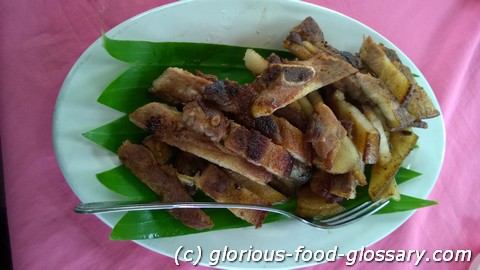Deutsch: Gegrillter Schweinebauch / Español: Panceta de cerdo a la parrilla / Português: Barriga de porco grelhada / Français: Poitrine de porc grillée / Italiano: Pancetta di maiale alla griglia
Inihaw na Liempo in the food context refers to a Filipino dish consisting of grilled pork belly. Known for its deliciously smoky flavor and a perfect balance of meat and fat, this dish is a popular choice at Filipino barbecues and gatherings. The pork belly is typically marinated before grilling, often in a mixture that includes soy sauce, vinegar or calamansi juice (a type of Philippine lime), garlic, sugar, and sometimes pepper or chili for added heat. The marination process infuses the meat with rich flavors and helps tenderize it, resulting in a succulent, flavorful dish that's crispy on the outside and tender on the inside.
Description
The appeal of Inihaw na Liempo lies in its combination of flavors and textures. The pork belly's fat renders out during grilling, leaving the meat moist and flavorful, while the high heat of the grill crisps the exterior. This dish exemplifies Filipino cuisine's fondness for grilled foods and showcases the culinary tradition of using simple, fresh ingredients to create complex flavors.
Application Areas
Inihaw na Liempo is commonly served as:
- Main Dish: Often accompanied by steamed rice and a side of atchara (pickled papaya) or a vinegar-based dipping sauce.
- Street Food: Available at street food stalls and markets, where it's typically served chopped into bite-sized pieces.
- Barbecue Item: A staple at outdoor barbecues and family gatherings, highlighting the communal aspect of Filipino dining.
Well-Known Examples
While Inihaw na Liempo itself is quite specific, variations might include:
- Spicy Inihaw na Liempo: Adding chili peppers to the marinade for a spicy kick.
- Inihaw na Liempo with Lemongrass: Incorporating lemongrass into the marinade for an aromatic flavor.
- Honey-Glazed Inihaw na Liempo: Using honey in the marinade or as a glaze for a sweet contrast to the savory pork.
Recipes
A basic recipe for Inihaw na Liempo involves:
-
Ingredients:
- 2 lbs pork belly, scored
- 1/2 cup soy sauce
- 1/4 cup vinegar or calamansi juice
- 1/4 cup brown sugar
- 6 cloves garlic, minced
- 1 teaspoon black pepper
- Optional: chili peppers, lemongrass, or honey for variation
-
Preparation:
- Combine soy sauce, vinegar or calamansi juice, brown sugar, garlic, and black pepper in a bowl to make the marinade. Add chili peppers or lemongrass if desired.
- Marinate the pork belly in the mixture for at least 3 hours or overnight in the refrigerator for best flavor absorption.
- Preheat the grill to medium-high heat.
- Grill the pork belly, turning occasionally, until it's cooked through and the skin is crispy, about 15-20 minutes. Apply honey as a glaze in the last few minutes of grilling if using.
- Let the meat rest for a few minutes before slicing.
- Serve with rice and dipping sauce or atchara.
Treatment and Risks
When preparing Inihaw na Liempo, it's important to cook the pork belly thoroughly to ensure it is safe to eat, while also managing to keep the meat tender and juicy. The high fat content in pork belly means it's best enjoyed in moderation, especially for individuals monitoring their fat intake.
Similar Terms or Synonyms
- Grilled Pork Belly
Summary
Inihaw na Liempo is a beloved Filipino dish featuring marinated and grilled pork belly, known for its rich flavors and satisfying texture. This dish is a testament to the Filipino love of grilling, offering a simple yet deeply flavorful experience that's perfect for any gathering or meal.
--
Inihaw na Liempo refers to grilled Liempo (pork belly). Pork is the English term for Karne ng Baboy (Meat of Pig).


